If you are touring around the city of Prague in the Czech Republic and happen to lose your wristwatch so you can’t tell what time it is, don’t worry. Proceed directly to the city center and you’ll get more than just the time of day. You’ll get a real show – on the hour every hour – with a mini lesson in Christian values thrown in.
The clock tower in Prague’s Old Town Hall is nothing less than a masterpiece! A medieval masterpiece to be precise. It’s most famous feature is a phenomenon known as the Orloj (Czech for “Clock”!) which is termed an “astronomical clock” because it doesn’t just tell you the time of day; it tells you the precise time of sunrise and sunset, the season you’re in, the phases of the moon, and the sun’s position in the zodiac. More on that below.
Brief History
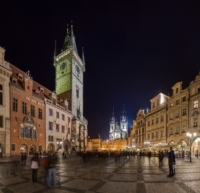 This magnificent clock was created in the year 1410 – two years before the birth of my favorite saint, Joan of Arc – but it has seen more battles than the warrior saint herself.
This magnificent clock was created in the year 1410 – two years before the birth of my favorite saint, Joan of Arc – but it has seen more battles than the warrior saint herself.
The clock witnessed the violent upheavals of the Bohemian heretic Jan Hus in the 15th century and the Protestant Revolution in the 16th. It also endured the disasters of World Wars I and II (it was heavily damaged by the Nazis in 1945); the Prague Uprising in 1968; and the Velvet Revolution freeing Czechoslovakia from Communist control in 1989.
Through all those centuries, there it stood, a stalwart sentinel marking time on earth, its spires pointing faithfully heavenward to a place beyond time.
We can’t say that it’s been continuously functioning since 1410, though. That would be impossible for a mechanism of this complexity. (I find it hard just to keep my bicycle in proper working order!)
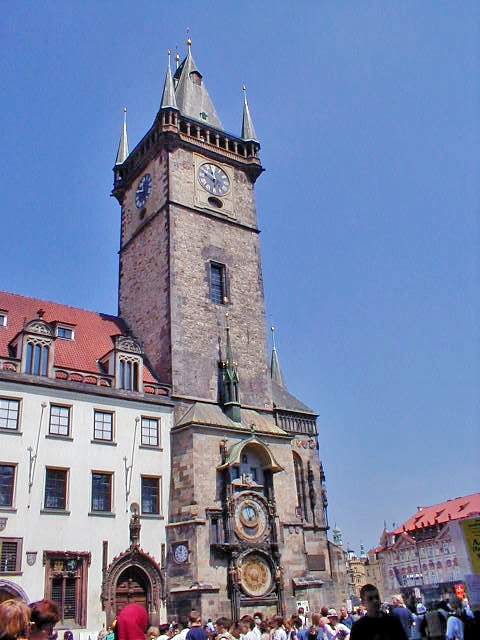
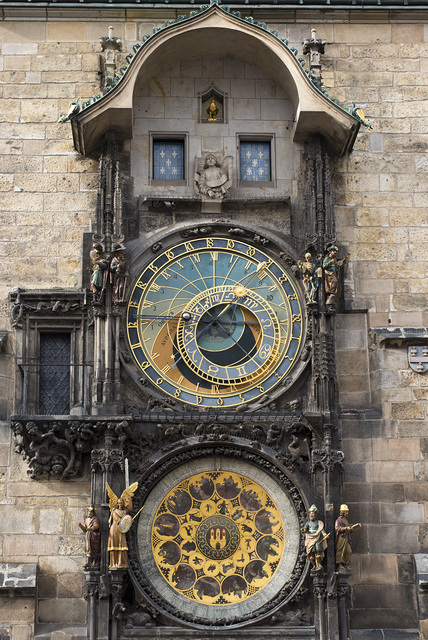
The Orloj has endured war, vandalism, neglect, and even gross mismanagement, forcing it into many years, sometimes whole decades of inactivity while the caretakers repaired and renovated it. Major additions and upgrades of the clock took place in 1470, 1552, 1659, 1787 (the year the US Constitution was ratified – feeling young yet?), 1948, 2005, and 2018.
To paraphrase a somewhat gauche American advertising slogan: for six centuries this clock has taken a licking and kept on ticking.
Astronomical Masterpiece
The Orloj consists of two sections, an upper clock (the astronomical clock proper) and a 12-month Church calendar underneath it. You almost need a graduate degree in mathematics or astronomy to figure out the workings of the clock. It is a layered series of concentric and overlapping circles that will leave you in awe of their complex interactions:
- The outer ring of the circle measures slightly under ten feet in diameter and displays symbols for the 24 zodiac signs, indicating the constellations and
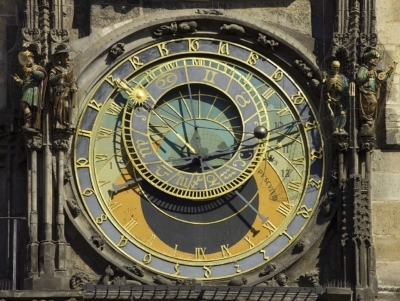 current season of the year (contrary to today, the zodiac signs had no New Age, occult meaning in the medieval mindset.)
current season of the year (contrary to today, the zodiac signs had no New Age, occult meaning in the medieval mindset.) - The inner rim presents a 24-hour clock in Roman numerals indicating the correct hour of the day (it has no minute or second hands);
- The colored inner areas of the face indicate, variously, the times of sunrise and sunset as well as partial maps of realms spanned by stars and planets;
- Revolving around the inside of the large circle is a smaller ring designating the revolutions of sun and moon;
- Tiny models of each heavenly orb dance about the outer rim: the moon actually revolves on the arm to show its phases; the sun has a hand above it pointing to the corresponding zodiac symbol on the outer rim.
Believe it or not, all of these complex mechanisms function in synch with each other in mechanical and astronomical precision (we’ll have to take the experts’ word for it.) As I said, it’s a real marvel.
The average person just knows that the Orloj rings precisely on the hour, every hour of the day, and that is of course its main attraction. Crowds of tourists gather every hour to hear its chimes and see its show.
The Divine Clockmaker
Most of the founders of the American republic were Deists. They believed that God was like a grand clockmaker who invented this incredibly complex world, wound it up like a timepiece, and then sat back and watched the activities play out like the intricate interaction of gears in a finely-tuned machine.
It was their view that God wasn’t much involved in His creation but left it up to us to calibrate and re-calibrate the great clock of human history because He had given man “dominion over the earth” (Genesis 1:28).
The Catholic creators of this clock had a different concept about how the universe worked. In their mind, God was still very much involved in His Creation. God and man worked together: God did what only He could do as the Creator of all things, and man does what he is supposed to do as moral actor and caretaker of God’s creation. God’s grace suffuses every movement of the heavens and leads humanity onward through time toward an eternity with Him.
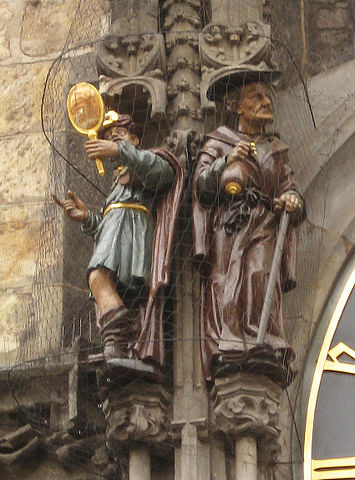
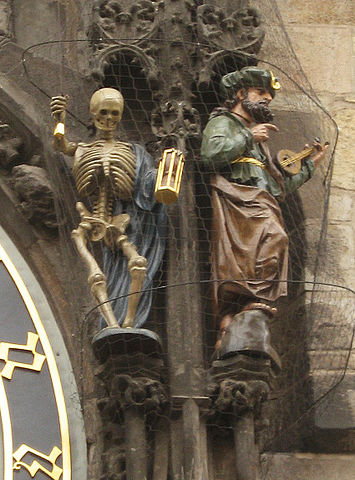
A Medieval Morality Play
That is why man is represented on this clock as a moral actor in this time-bound drama. The moving figures on the Orloj give the viewers a large dose of the most basic moral message: “Do good and avoid evil.” Four figures stationed on either side of the clock represent things we definitely need to avoid because they will cause us to lose our salvation. These figures act out a kind of mini morality play in situ:
- Vanity: gazes at himself in a mirror
- Greed: holds a money bag
- Sin: a skeleton reminds viewers that “the wages of sin is death”;
- Lust: holds a lute and is dressed for some serious worldly pleasure-seeking.
Each of these figures moves when the clock chimes – especially the skeleton shaking the bell in this right hand – to focus the viewer’s attention and remind man of the dangers of the immoral life.
The Lower Clock
If you look carefully at the area underneath the astronomical clock, you will see a counterbalance to the dangerous vices above. The lower section features a round, 12-month calendar that fits into a slightly smaller circle than the clock. Prague’s coat of arms adorns the very center while Christian allegories of the twelve months of the year surround it.
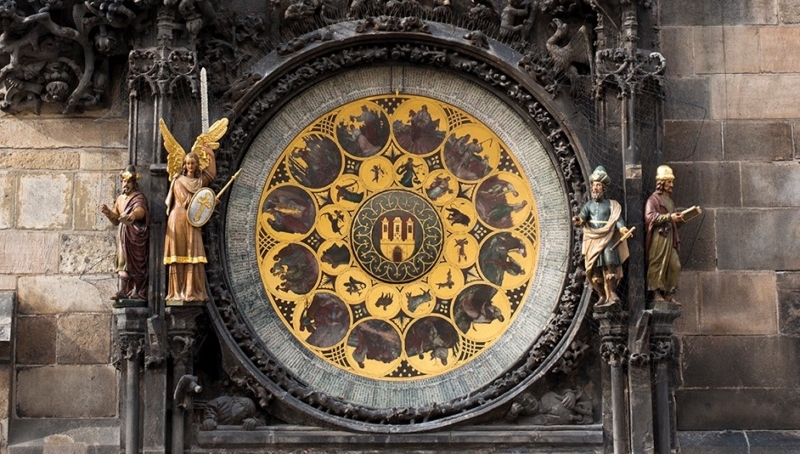
The calendar, too, is flanked by several interesting figures who emphasize man’s higher nature and the virtues for which he should strive:
- A philosopher (representing the pursuit of wisdom);
- An angel (religion)
- An astronomer (science), and
- A chronicler (education and history).
Closer to the viewers and standing as a rebuke to the vices above, these four are meant to convey the simple moral message that we must pursue virtue and religious culture if we wish to enter the kingdom of heaven.
It may not be apparent from a distance, but the grey outer ring encircling the calendar consists of 365 saints that make up the Church calendar – one for each day!
The Best Part
The reason tourists keep flocking to the town hall is not because they’ve lost their watches or because they hunger for the moral message of the clock (alas!) They really come for the entertainment.
Two windows above the Orloj flank a carved angel and open mechanically every hour at the ringing of the bells. In a typical medieval theme, you can see a revolving band of Apostles parading past the windows for 27 whole seconds while the bells play out.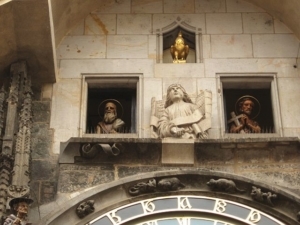
(I’ve read no commentary about the symbolism of the number 27, but the medieval mind had to have a reason, I just know it! Could it be a symbolic tripling of the Trinitarian number, 3x3x3, maybe? Hmmm.)
Finally, at least thirty feet above the parade of Apostles (in a gallery near the roof), a human trumpeter emerges dressed in a medieval costume and marks the hour by blowing a quaint tune to end the show. You’ll see him at the end of the first video below. (What a great job to have!)
I think you’ll be fascinated, as I was, by two very brief videos of the delightful show, which will give you a better sense of the drama.
The Hourly Show (duration, 1:40)
Computer simulation of clock (0:34)
Behind the scenes view (1:08)
Evangelization Tools
Could an instrument that measures earthly time be a sacred window, the bearer of a transcendent message? Well, the early Jesuit missionaries thought so.
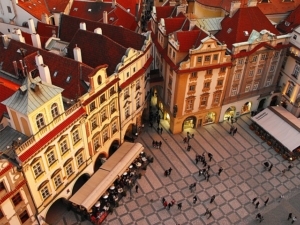 Both St. Francis Xavier (1506-1552) and Matteo Ricci (1552-1610) evangelized the Japanese and Chinese peoples, respectively, with gifts of Western clocks. It was the first time anyone in those cultures had ever seen a mechanical clock (!), and the wise men of the East were utterly fascinated by these devices, as one would imagine.
Both St. Francis Xavier (1506-1552) and Matteo Ricci (1552-1610) evangelized the Japanese and Chinese peoples, respectively, with gifts of Western clocks. It was the first time anyone in those cultures had ever seen a mechanical clock (!), and the wise men of the East were utterly fascinated by these devices, as one would imagine.
The missionaries knew that intelligent men who search the heavens for meaning would find a clock to be a fitting metaphor for the grand design of the universe and infer from their insights the existence of a Grand Designer. Out of the clock image, the missionaries drew a whole series of lessons to explain the Christian faith:
- An intricate machine like that was just a reflection of an infinite Mind who created time itself;
- The God who designed an intelligible universe is also the One who put it back in working order when it got corrupted through sin;
- A rational moral order maintains the smooth functioning of human society like the laws of physics maintain a mechanical device or the movement of the stars;
- And there were many more explanations of that sort.
Their message was convincing: if this Clockmaker could create such an intricate and beautiful world for His children, how much more splendid must His home be… beyond our universe of space and time.
Note—The astronomical clock in Prague is one of several medieval timepieces in Europe that are still functioning. If you’re interested, check out the Wikipedia pages of two other famous ones (both of which are inside cathedrals). However, Europe is actually full of these types of clocks (see this fascinating Wikipedia entry)!
———-
[Note: This article is a reproduction of the Sacred Windows Email Newsletter of 11/06/22, so it does not end with the regular Soul Work section. Please visit our Newsletter Archives.]
All images courtesy of Wikimedia.
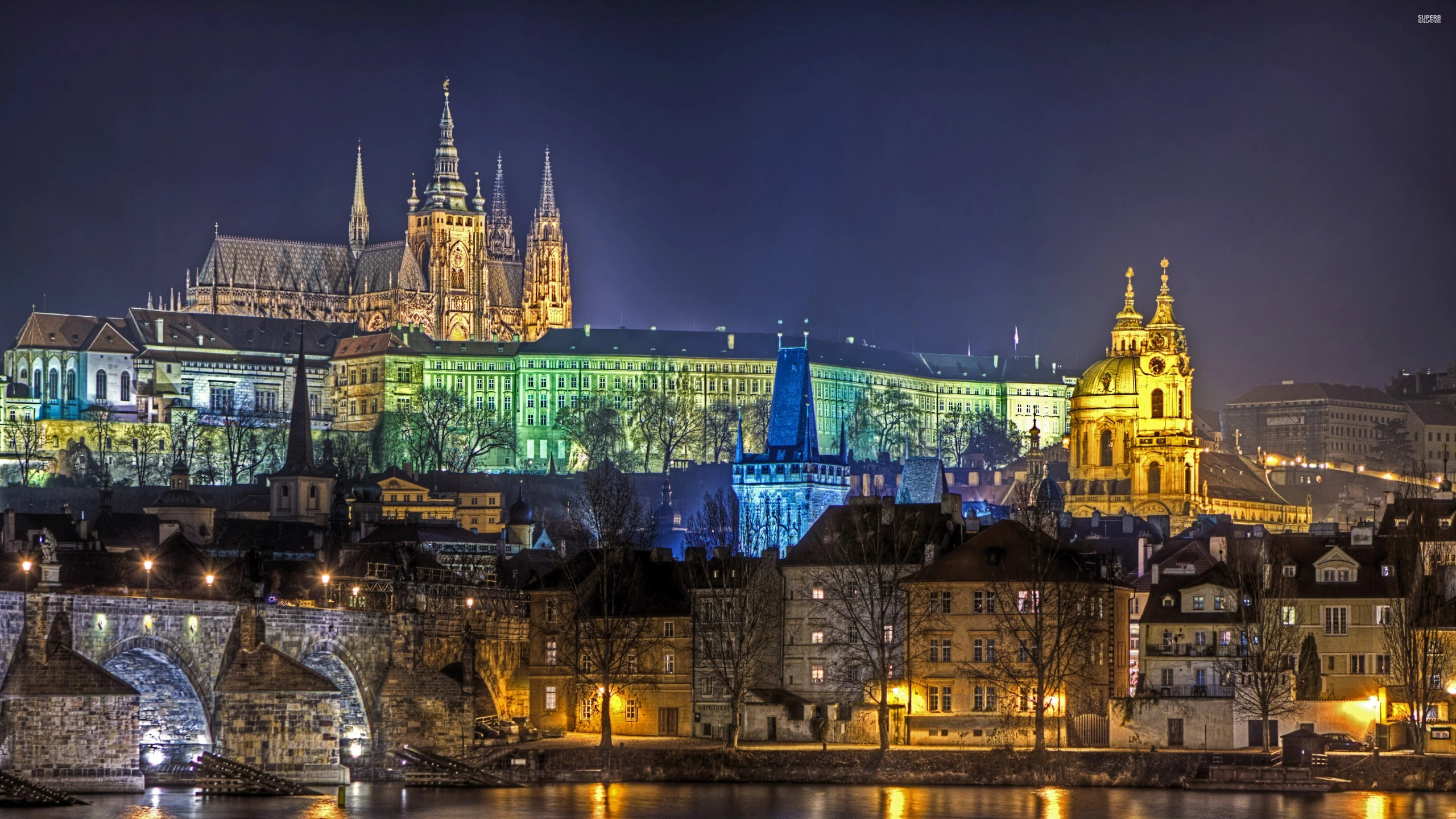
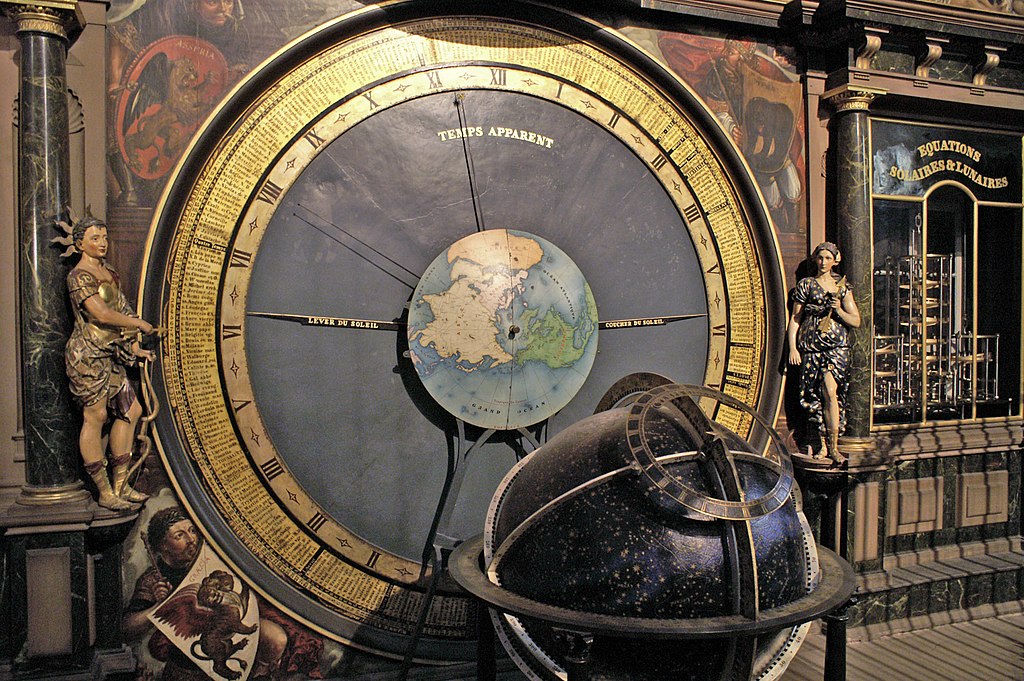
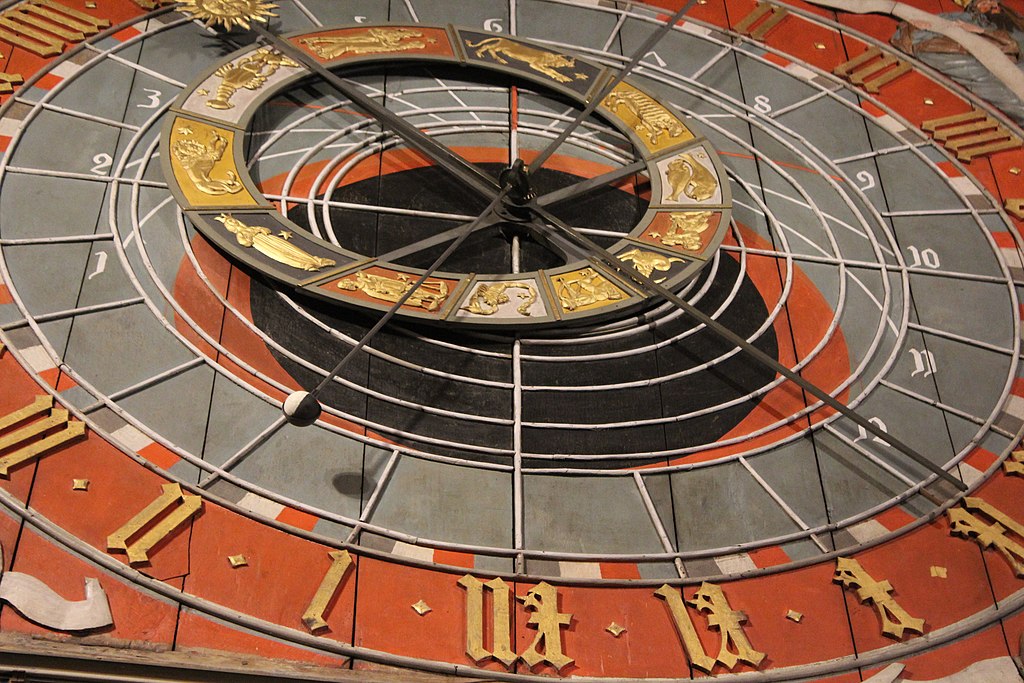


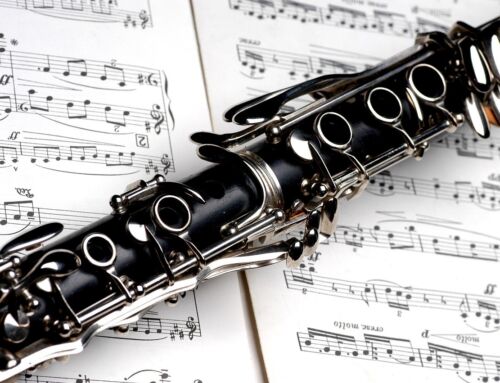
Leave A Comment